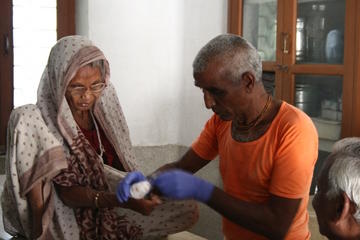
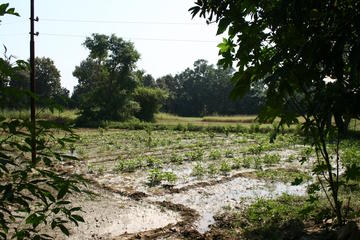
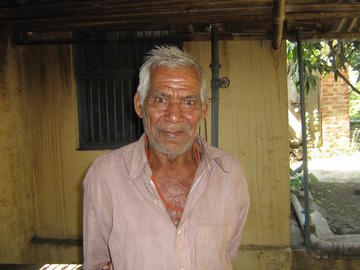
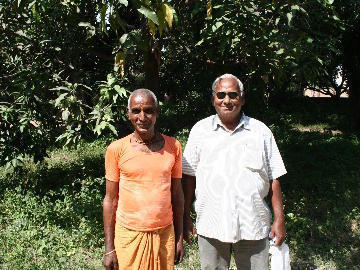
Impressions of DISCCPart 3, Leprosy programs14-24 October 2008 |
The following day, we visited Sarnath, 15 km from Varanasi, the site of the Buddha's first speech to his friends, in which he presented his vision of the human condition and the means for improving it. Sarnath is also the site of DISCC's Ashapur Center for victims of leprosy, an organism of which the Buddha would have certainly approved. Our driver for the day was Santosh, who had been Tulsi's driver before he had a bad motorcycle accident in 2006. The DISCC Help Line came to his aid and saved his leg that was fractured in 18 places in a long series of operations.
We visited the Ashapur site with Upadhyaya, another very pleasant member of the DISCC staff who functions as a male nurse, or medical assistant, and changes bandages on the lepers. He and Ramesh, who is in charge of the site, showed us around. To watch as Upadhyaya bandages wounds requires a firm will. It was an experience which forced us to take note of the existence of aspects of the human condition we westerners tend (prefer?) to ignore. The extent of the damage particularly to feet and hands was in remarkable contrast to the smiles and quiet chatting of those suffering from them. There was a general air of a gathering of friends waiting patiently for Upadhyaya's attentions. Quite amazing -- and moving.
 |
 |
| Patient being bandaged by Swami Ramesh Chandrea Srivastav | Planted field |
 |
 |
| Mr Ram Dular Singh | Ramesh and Upadhyaya |
The Ashapur site is far larger than the Sankat Mochan one, though we saw fewer people there. Contrary to the practice at Sankat Mochan, many of the leprosy victims treated at Ashapur do not live there. We visited the recently-refurbished kitchen and sanitary facilities and admired the extensive agricultural area where the residents were cultivating various crops, for their own use or even for selling, mango trees and various other recently planted trees and bushes providing edible fruits.
Afterwards, Upadhyaya returned to Varanasi and we visited the Sarnath Museum and admired the beautiful sculptures, especially a gorgeous Buddha from the Gupta period and the four-lioned top of the Ashoka column, which is now an official symbol of India and represented on banknotes.
We had a delicious lunch with Santosh at the Highway Inn, where we had eaten with the Portas in 2006 but failed to find during our visit in 2007. On the suggestion of Tulsi, we visited Vajra Vidya Monastery and Dispensary, which includes a gorgeous Buddhist Temple. Before arriving in Varanasi, we had spent two days in Bodhnath, in the eastern part of Kathmandu in Nepal. Bodhnath is also a Tibetan Buddhist center, including 32 monasteries. One of them was just across from our hotel window and we could hear the monks chanting and playing drums and horns. So it was an unexpected and delightful experience to arrive at Vajra Vidya just as they were doing the same thing. And what a show! The monks were seated in two rows, on the left and the right, with the huge golden figure of the Buddha visible in the background between the rows. There would be a period of maybe two or three minutes of everyone chanting in different tones and rhythms. The result is not the hubbub expected but an enthralling kind of toneless and arhythmic but nevertheless musical experience. Then some monks would blow on huge alpenhorn-like horns while others played shorter, straight instruments resembling medieval sackbuts. At the same time, the two men closest to the foreground in each row pounded on large suspended drums. The result was a crescendo fortissimo of great emotional and musical impact. Wild! We loved it.
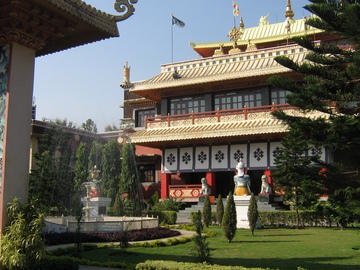 |
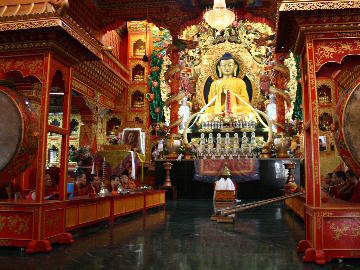 |
| Vajra Vidya Monastery | |
The next afternoon, we visited the Sankat Mochan Center with Upadhyaya. Again, we assisted as he changed bandages and here we saw the worst wound, a foot wound that must have been an inch deep. But again, we were impressed by the good-naturedness of the people being treated. It seemed to us that they knew each other better, or maybe were members of the same family, and had a kind of quiet understanding of their situation which enabled them to surmount their difficulties and to live with admirable equanimity. We put this down partially to their actually living together there. They cared for each other and smiled as they were being cared for! At least one woman was quite beautiful, aside from her wounds. Real solidarity!
People at the Sankat Mochan Center live together with their families. The Center is comprised of a lane parallel to the street, with dwellings on each side, a temple to the goddess Kali in the middle and a meeting hall at one end. The place has been repainted lately and the last touches were being put on the temple sikhara or tower. The sunlight is filtered through leafy trees and the net effect is quite charming. As Doortje Tielemans pointed out though, you must not look at the edges of the stream which runs behind the center, which are strewn with garbage. This again is one of the contrasts that are India.
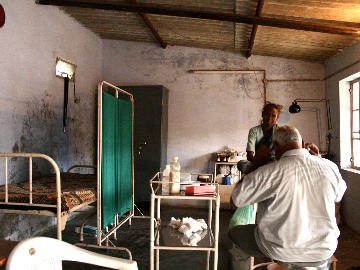 |
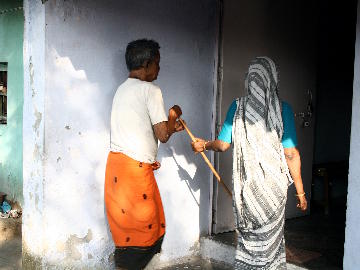 |
| Upadhaya at work | Helping each other |
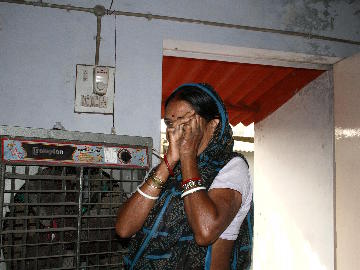 |
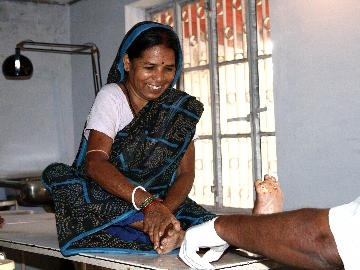 |
| Shy | Being bandaged |
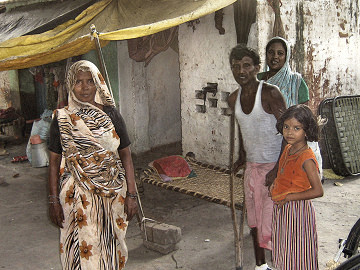 |
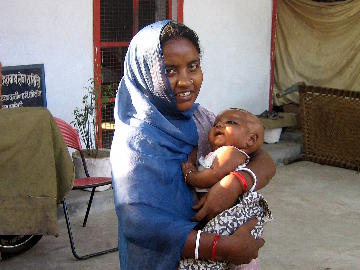 |
| The patients look quite happy - the little girl is healthy and living with her mother. |
Mrs Thumpa and her baby |
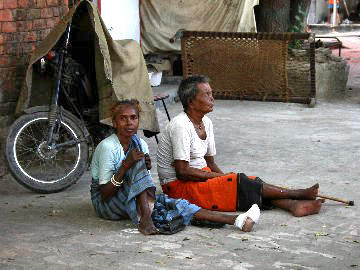 |
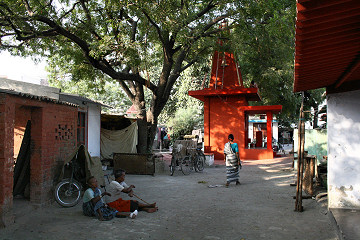 |
| Husband and wife, Mr Kali Charan and Mrs Mandodari | Sankat Mochan Center and Kali Temple |
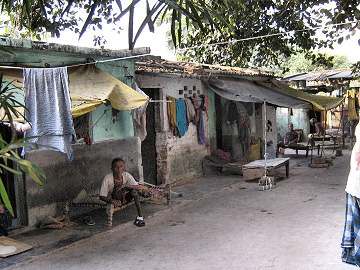 |
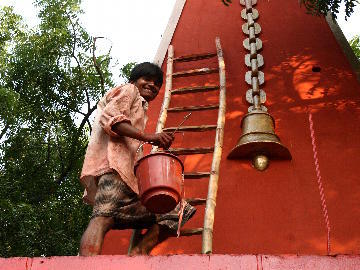 |
| A 'street' at Sankat Mochan where every family has their own modest 'house'. |
Painting the temple sikhara |
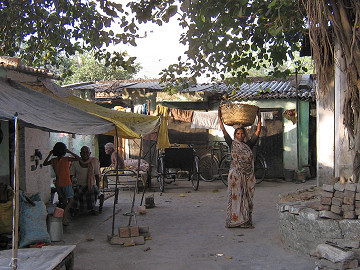 |
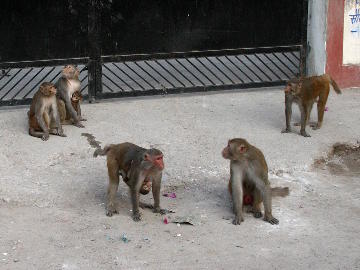 |
| Sankat Mochan Center where life is going on. | Monkeys in street |
To say that India is a land of contrasts is a gross understatement. It has also been stated that it is a museum in which past and present live together side by side and we agree with this assessment. We insist also that it is a land of sensations – colors, sounds and, especially, smells, to the point that one returns from there suffering from sensory overload. But what impressed us most was what we saw again and again, namely, examples of solidarity, or cooperation, in spite of difference. For us, this became the dominant theme behind DISCC activities, We wish it could be exported to the west!
Returning from Sankat Mochan, which is a few hundred meters from the temple of the same name dedicated to the monkey god Hanuman, we came across a large group of – what else? – monkeys. They swarmed over trees, houses and fences and eventually ran across the road and up to the roof of the dwellings in the Center for leprosy victims. Monkeys don't have the same squeamishness we do!
Continue to Part 4, schools.